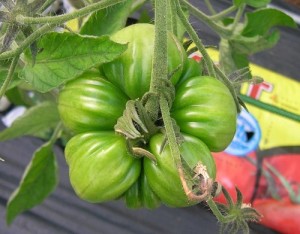Large Tomatoes Grow in Segments
Here’s a good example of how large tomatoes grow in segments, a bit like oranges. This is Hill Billy Potato Leaf below.

Each segment needs to be pollinated, but when a segment fails to pollinate, the mature fruit grows into a strange shape – perfectly OK to eat, but would never reach the supermarket shelves!
The one in the pic is not fully grown and will look a lot more like a tomato in a few weeks time!
.
First To Mature
My first cherry tomato to mature this season was Red Alert, the first medium size – salad tomato – to mature was Orkado F1 and the first Large variety to mature was Oregon Spring.
Poor Weather Conditions and Resisting Disease
Although we had very poor weather for growing tomatoes in the UK until recently, the tomato plants that survived are now growing at a good speed. However, many growers, especially those who grow outside, lost their entire crop.
Disease Resistance
Much is made of blight resistance or tolerance, and the ability of a variety to resist certain fungal diseases. Disease resistance plays an important role in getting tomato plants through periods of wet weather to better spells and dry conditions.
Here are five new disease resistant hybrid varieties bred by Pro-Veg Seeds. One of which you may already recognise, and are well worth looking out for next season.
- Bitonto F1
- Terenzo F1
- Losetto F1
- Lizzano F1
- Siderno F1
Plant Nutrition
However, this season I have delved much deeper into plant nutrition – especially additives, and have found that by keeping plants healthy and their immune systems high, plants have been able to resist many diseases they would have otherwise succumbed to – even the plants that have been growing outside remained disease free, in almost three months of continual rain!
I’m not saying that feeding the right stuff to tomato plants will prevent all diseases, but it certainly helps build resistance!
The Last Resort
Of course there’s always the last resort of using an anti-fungicide like Systhane or Bordeaux Mixture but that’s not an option for those who are growing organically.
I do hope that Serenade will be available soon in the UK. As a bio-fungicide it protects by covering the root zone and leaves with friendly fungi which protects against the fungi that cause disease – clever stuff!
There are some products that are used by those who grow hydroponically (without soil) that are similar to Serenade and are available in the UK – I’ll let you know more about these next week.
Anyway, I do hope that your plants are well (and you too!) and you’ve plenty of tomatoes to look forward to.


jess allaway
P.S. Sorry, I should have said that these yellowing leaves are all over the plant and not the usual bottom leaves which we remove as they yellow.
jess allaway
Hi Nick,
I previously said that my Latah tomatoes were cropping well and that I had hoped they would replace my failed Red Alerts (fresh seed this year – still puzzling me why they didn’t germinate!). However, that was wrong information – the early plants were not Latah but actually Glacier. Latah have been very poor and probably about a quarter of the size of the Glacier plants. The Glacier are the ones that are very sprawling and up to the roof. One thing I am noticing is that their leaves, which are big potato type, are beginning to turn very light green and some almost golden and crisping at the edges. They have loads of toms on them and I hope to keep the plant healthy to finally crop those. Would a spray of epsom salts help do you think? I hate spraying anything when lots of the toms are almost ripe. Also the leaves of Glacier have been much lighter green from day one, but certainly not this light. Any advice would be most welcome.
Nick
Hi Jess,
The Epsom Salts won’t do them any harm although the fading green leaves
sounds as if the plants are running out of steam.
I would spray them with an all-round nutrient such as Miracle Grow which
contains micro nutrients.
Although I found Latah to be early, I wasn’t very impressed as the
tomatoes were inconsistent in size and number on each plant.
The crispy gold edges could be a number of problems including early
blight – plants don’t always display their diseases the same as in the
photos but here’s a few for you to look at:
http://aggie-horticulture.tamu.edu/vegetable/tomato-problem-solver/leaves/
If the fruit are almost ripe I would focus on boosting the plant’s
energy with foliar food, but too much nitrogen can delay toms ripening.
Regards,
Nick
Rhys Jaggar
My Shirley plants have grown really well outside in the garden and are now producing as much fruit as the sheltered ones in pots – they will crop a bit later, but the crop size will be every bit as good. As these were the ‘runts of the litter’ early on, they clearly can cope with the rain OK. I’ve let the main stem divide into two or three as this speeds up the number of trusses, which has now reached 7 – 10 on the four plants. Plenty of fruit are forming on the upper trusses, unlike the plants in 10 inch pots, which seem to have maxed out on three fantastic trusses and 3 – 4 fruit on the next ones.
Our Tumbler plant has nearly finished cropping (juicy, delicious and easy to grow). The Alicante and Shirleys are now producing plenty of ripe, tasty fruit under the car port and the Shirleys in the garden are also now starting to crop. I”m sure it was a complete fluke, but the first Shirley was harvested 5 months to the day that I planted the seeds indoors (March 7th to August 7th).